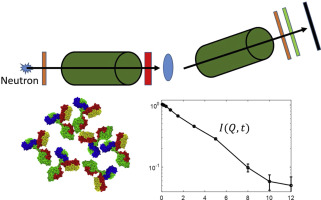Current Opinion in Colloid & Interface Science ( IF 8.9 ) Pub Date : 2019-08-06 , DOI: 10.1016/j.cocis.2019.07.002 Yun Liu

|
Dynamics of proteins in solutions include translational, rotational, and internal motions that are linked to different protein properties. Because most proteins are small with the sizes just a few nanometers, the time scale for its short time dynamics usually range from a few nanoseconds to a few hundreds of nanoseconds, during which a protein usually does not rotate too much. Protein short-time dynamics have been shown to be useful to study liquid theories, protein cluster formation, gelation transitions of concentrated protein systems, and protein internal motions. Neutron spin echo, which is able to measure protein motions with the right correlation time at the appropriate length scale, is ideally suitable to study the short-time dynamics of proteins in solutions. Here we review recent activities of using neutron spin echo to study the protein short-time motions. Despite all the progresses, there are still both theoretical and experimental challenges to exploit the full capability of neutron spin echo to study protein dynamics.
中文翻译:

中子自旋回波研究溶液中蛋白质的短时动力学
溶液中蛋白质的动力学包括与不同蛋白质特性相关的平移,旋转和内部运动。因为大多数蛋白质很小,大小只有几纳米,所以其短时动力学的时间尺度通常在几纳秒到几百纳秒之间,在此期间,蛋白质通常不会旋转太多。蛋白质短时动力学已被证明可用于研究液体理论,蛋白质簇的形成,浓缩蛋白质系统的凝胶化转变以及蛋白质内部运动。中子自旋回波能够在适当的长度范围内以正确的相关时间测量蛋白质运动,非常适合研究溶液中蛋白质的短时动力学。在这里,我们回顾使用中子自旋回波来研究蛋白质短时运动的最新活动。尽管取得了所有进展,但利用中子自旋回波的全部功能研究蛋白质动力学仍然存在理论和实验挑战。



























 京公网安备 11010802027423号
京公网安备 11010802027423号